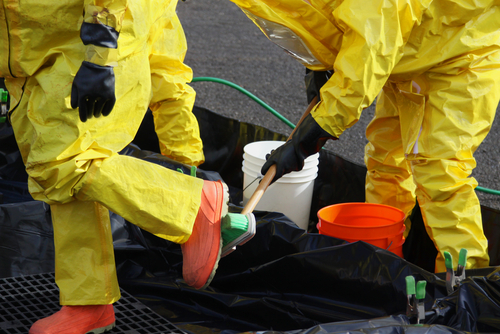
|
Here is an overview of what you need to know to put together an effective training session.
Background
Who needs to be trained? If your employees work with hazards that could inadvertently be carried home, they need to know that they could place family members at risk and how to avoid doing so. Also, some workplace tools that look like they could be useful at home could instead be dangerous—warn your workers about them, too.
Why train workers in workplace hazards that can affect the home? Some hazards that may not affect a healthy adult can have devastating effects on children. Workers don’t want to hurt their families, but unless they know about the risks, they may not take required precautions, such as leaving contaminated work clothes at work.
Basics
Instructions to trainer: If specific programs in the workplace protect workers’ families, make sure workers know why these programs are important. For example, the employer may launder contaminated work clothes or provide tools that are to be left at work because of potential contamination. If employees don’t understand the reasons for the program, they may not comply with it due to convenience or personal preference.
Training introduction: You wouldn’t send a child to do an adult’s job, would you? But if you’re not careful about what you’re carrying home from work, you could expose your children or other vulnerable family members to hazards you face at work.
Don’t take the following hazards home to your family:
Your one-stop safety management resource, available 24/7. Go here to take a no-cost site tour or here to try it in your own office!
Hazardous Chemicals
Chemical contamination is one of the most common hazards carried from the workplace into the home. Contamination may be carried on the skin or clothes.
According to a study conducted by the National Institute for Occupational Safety and Health (NIOSH), workers have inadvertently exposed their families to hazardous chemicals that include:
- Beryllium and asbestos, which can cause chronic lung disease;
- Lead, which can cause brain damage and developmental delays, and is dangerous to children at much lower levels than are hazardous to adults;
- Mercury, which causes nerve damage, including brain damage;
- Arsenic and cadmium, which can cause poisoning, especially in children;
- Pesticides, which can cause both acute poisoning and chronic health problems like asthma;
- Caustic farm products, which are known to have poisoned farm children;
- Chlorinated hydrocarbons, which are used in plastics, solvents, and pesticides and are environmental toxins that can harm human health;
- Hormone-like chemicals, which can be carried home from farms and pharmaceutical operations and affect the development of both boys and girls; and
- Fibrous glass, which can cause skin irritation in family members when a family’s clothes are washed together with a worker’s clothing that contains the substance.
Great news! BLR’s renowned Safety.BLR.com® website now has even more time-saving features. Take our no-cost site tour! Or better yet, try it at no cost or obligation for a full 2 weeks.
Hazardous Biological Agents
Chemicals are not the only hazard workers may track home by mistake. Some hazardous biological substances can migrate home with workers, too, including:
- Asthmogens, allergens, and sensitizers. Allergies and asthmatic reactions to pet dander, pollen, mold, and other biological agents are common. If you encounter any of these at work, be careful not to bring them home to family members.
- Infectious agents. Workers in hospitals, laboratories, and agricultural facilities can carry home infectious diseases on their clothing and skin.
Radioactive Materials
Workers may carry home radioactive materials as contamination on their skin or clothing, or they may carry home radioactive tools and devices without realizing it, exposing their families.
Prevention Precautions
Prevent the exposures described above by:
- Knowing what’s on your clothes. If your work clothes may be contaminated, change before you leave work. If you take the clothes home with you, have a way of storing and laundering them separately from your family’s other laundry.
- Cleaning your skin. If you can shower before leaving work, you’ll remove contamination that’s on your skin and in your hair.
- Leaving contaminated items at work. Even if no one would mind if you took home tools, scrap materials, or packaging from the workplace, bear in mind that these may be contaminated. Don’t expose your family.
Also remember that family members can be exposed to hazardous materials when they visit you on the job. So make sure you thoroughly follow your organization’s restrictions on nonemployees in the workplace in order to protect your family.
Why It Matters
- Some safety hazards can extend beyond the workplace.
- If they do, those hazards could have repercussions that come back to affect the workplace through lost workdays, increased healthcare insurance premiums, or other expenses.
- Train your workers to take precautions that will keep them from bringing safety hazards home with them.
